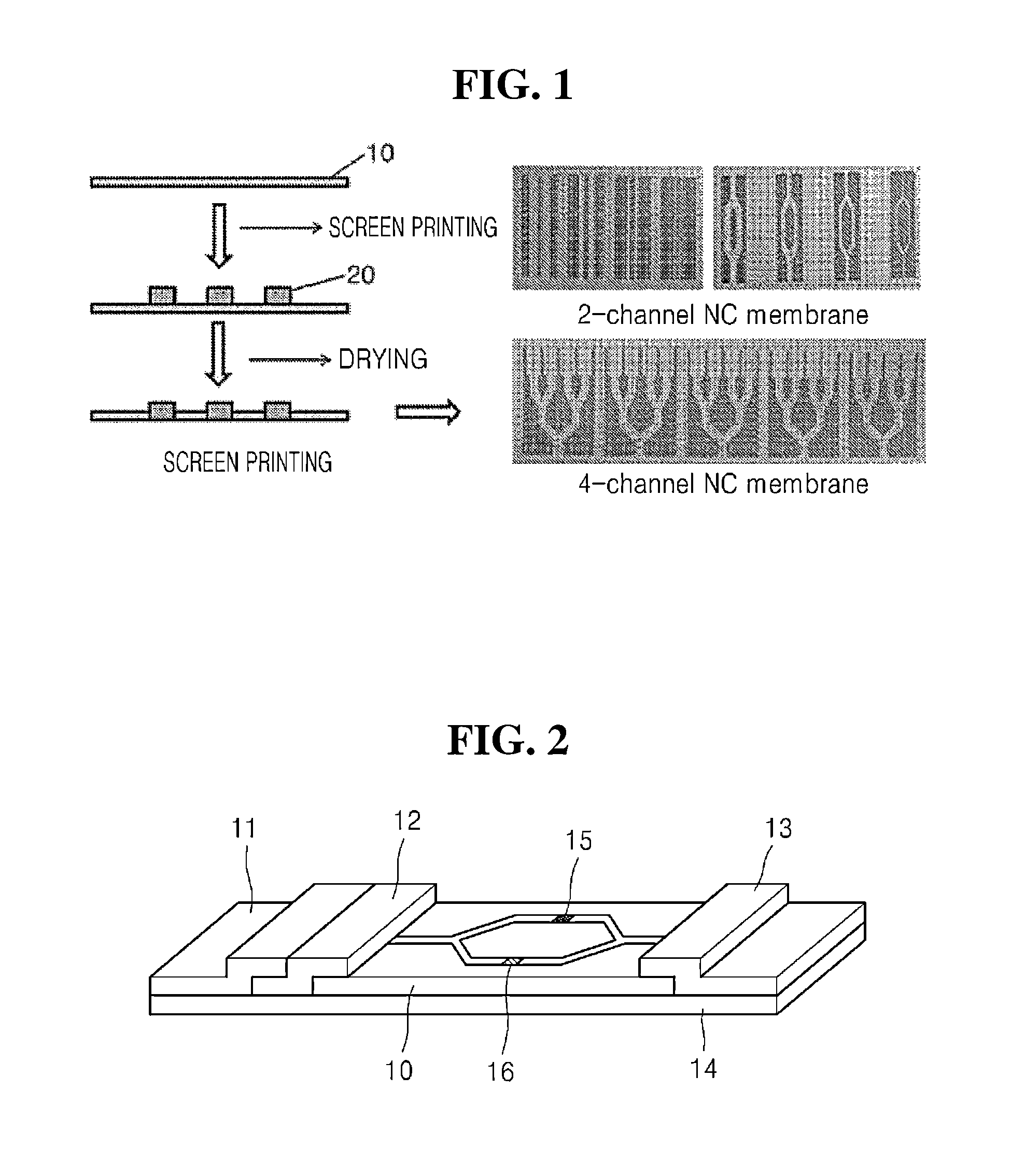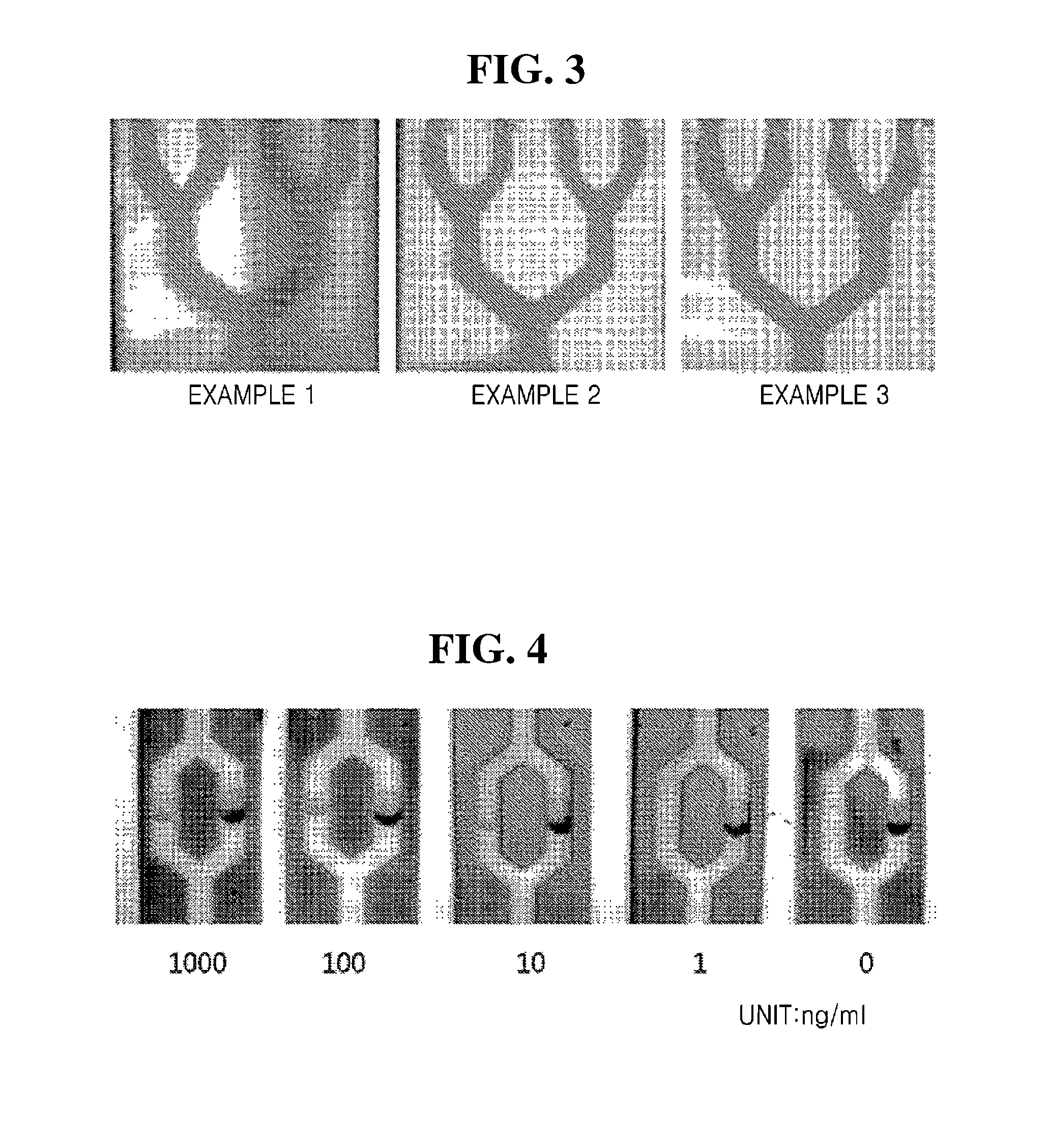Method for manufacturing multiple-diagnosis membrane sensor by using screen printing
- Summary
- Abstract
- Description
- Claims
- Application Information
AI Technical Summary
Benefits of technology
Problems solved by technology
Method used
Image
Examples
example 1
Manufacturing of Multiple Channel Membrane by Screen Printing
[0049]A silver paste as hydrophobic ink was screen printed onto a nitrocellulose membrane (Millipore, 180 sec Nitrocellulose, 4 mm×25 mm) at a thickness of 5 to 10 μm so that four channels were formed as shown in FIG. 1. Then, the silver paste printed membrane was dried at room temperature for 15 minutes and then treated at a drying oven at 100° C. for 1 hour, thereby finally obtaining a multiple channel membrane.
examples 2 and 3
Screen Printing Using Organic Solvent
[0050]A membrane was manufactured by the same method as in Example 1 except for performing a screen printing process after mixing ethanol with the silver paste so that contents of ethanol were 5 wt % and 10 wt %, respectively.
[0051]A phosphate buffer saline (PBS, Gibco, USA) solution containing 1% (w / v) protease-free bovine serum albumin (BSA, Fitzerald) was flowed into the prepared multiple channel membrane, and flows spread around the patterns were confirmed. The results were shown in FIG. 3.
[0052]As shown in FIG. 3, it may be appreciated that in the case of the pattern formed by printing the silver paste to which ethanol was added, a solution spread around the channel was significantly decreased as compared to the pattern formed by printing the silver paste to which ethanol was not added. Particularly, in the case in which 10 w % of ethanol was added, flows spread around the pattern were almost non-existent. Generally, since the nitrocellulose...
example 4
Measurement of C-Reactive Protein (CRP) in Human Serum Using Biosensor
[0053]4-1. Synthesis of Gold-Nanoparticle-Antibody Conjugate
[0054]0.1 mL of 0.1M boric acid buffer (pH 8.5) was put into 1 mL of gold nanoparticle colloid solution (20 nm, BBInternational, GB) and then 10 μl of anti-CRP antibody (Abcam, 1 mg / mL) was added thereto, followed by reaction for 30 minutes. After the reaction, 0.1 mL of a solution obtained by dissolving 1% (w / v) protease-free bovine serum albumin (BSA, Fitzerald) in phosphate buffer saline (PBS, Gibco, USA) was added thereto, followed by reaction at 4° C. for 60 minutes. After the reaction, the reactant was centrifuged at 4° C. and 10,000 rpm for 20 minutes, and the resultant was purified and recovered by putting 1 mL of BSA solution (1 mg / mL) dissolved in 10 mM PBS three times, thereby synthesizing a gold nanoparticle-antibody conjugate. After the synthesized gold nanoparticle-antibody conjugate was concentrated 2.5 times, the concentrated conjugate was...
PUM
 Login to View More
Login to View More Abstract
Description
Claims
Application Information
 Login to View More
Login to View More - R&D
- Intellectual Property
- Life Sciences
- Materials
- Tech Scout
- Unparalleled Data Quality
- Higher Quality Content
- 60% Fewer Hallucinations
Browse by: Latest US Patents, China's latest patents, Technical Efficacy Thesaurus, Application Domain, Technology Topic, Popular Technical Reports.
© 2025 PatSnap. All rights reserved.Legal|Privacy policy|Modern Slavery Act Transparency Statement|Sitemap|About US| Contact US: help@patsnap.com



